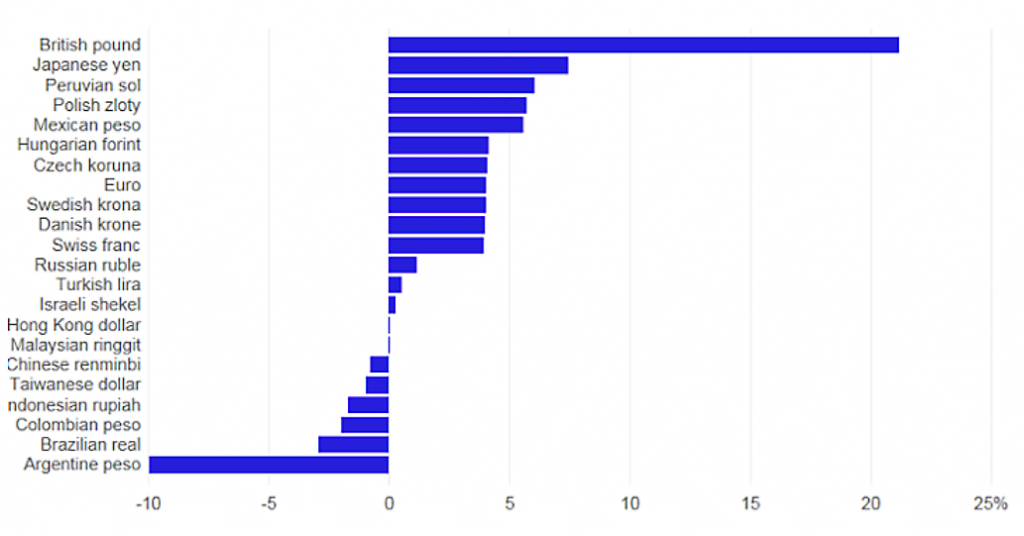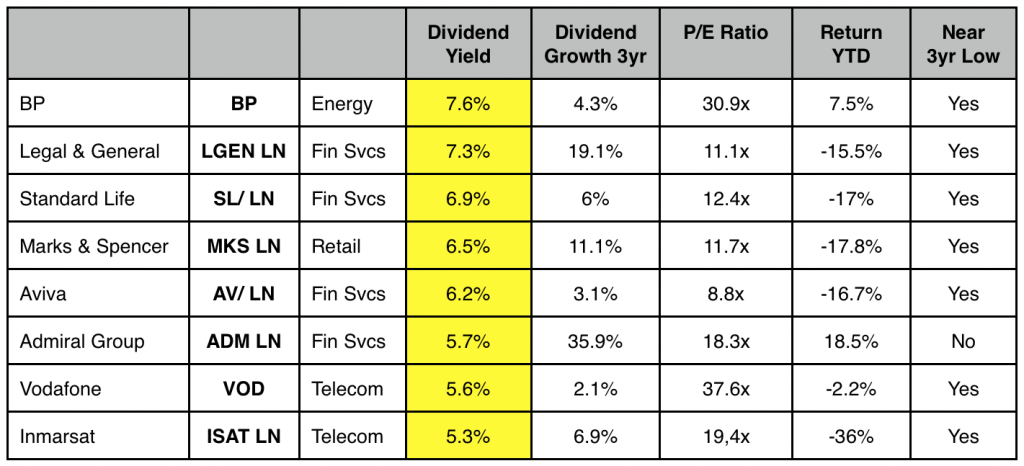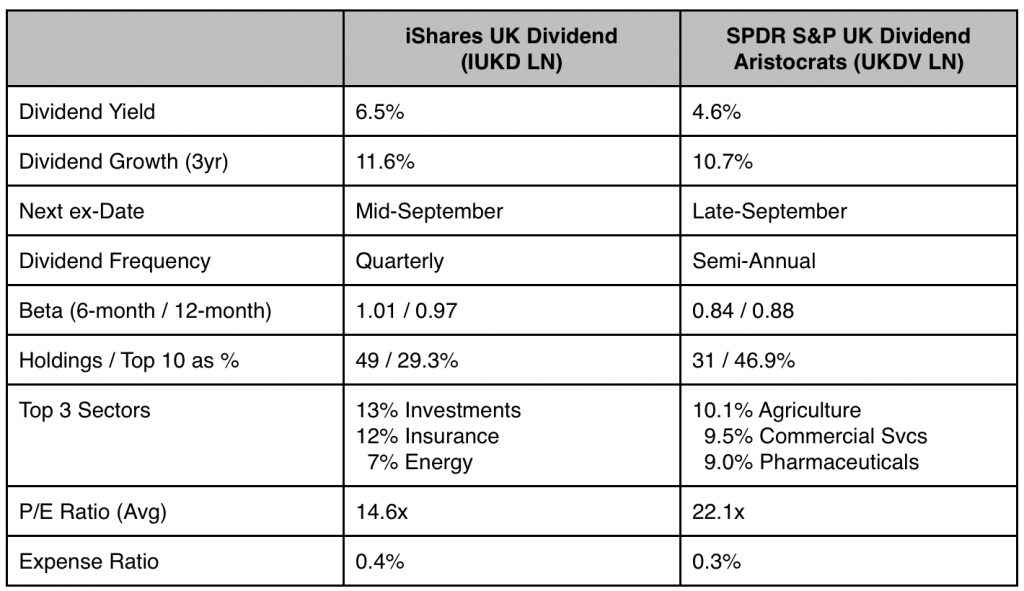Rule Britannia
Eight U.K. Dividend Aristocrats
- Brexit has skewered UK assets to create significant value among dividend paying companies
- FTSE 100 Index now trades at a discount to peers despite higher GDP and lower unemployment
- 16 of 100 FTSE components yield at least 5% compared to zero companies in the DJIA
- Bloomberg model identifies 8 UK-based companies likely to increase dividends near-term
No man is an island. Unless he’s British. The historic #Brexit vote by 51.9% of the UK population asserts Britain as independent and unbundled from the global bear hug wrought by asset inflating central banks. While perhaps noble in its intent –even refreshing to the fiscally-minded among us– stocks plunged 9% and the venerable British Pound dropped to a 31-year low. Then something happened. Buyers stepped in. Take quality assets down far enough and value speaks for itself. UK dividend paying stocks offer particular reward.
Emotion ahead of the vote, as well as the unprecedented plunges overnight have created a some compelling opportunities for thoughtful long-term investors. With so many traders betting on a negative outcome, short interest on Sterling futures has soared to new highs in recent weeks. Similar story for the cost of transacting in the options market, where implied volatility on the currency’s options had risen 22%, more than four times the rate on the Euro. (chart from Bloomberg).  Incredibly, the GBP spike occurred even as implied vols declined for Brazil and Argentina… which feature zika and 40% inflation, respectively. Equity markets too reflect angst. #Brexit has wreaked so much havoc on valuation that only Italy trades at a cheaper ratio of price to earnings among Europe’s major markets. Yes Italy, where unemployment still hovers above 11%, more than twice that of the UK. I’m focused on British dividend paying stocks. Simply put, they are far too cheap and their dividend yields are far too compelling to ignore. Plus, earnings are rising and the cheaper Pound should help exports (assuming bitter EU ministers don’t impose punitive tariffs). Compare Britain to the rest of Europe.
Incredibly, the GBP spike occurred even as implied vols declined for Brazil and Argentina… which feature zika and 40% inflation, respectively. Equity markets too reflect angst. #Brexit has wreaked so much havoc on valuation that only Italy trades at a cheaper ratio of price to earnings among Europe’s major markets. Yes Italy, where unemployment still hovers above 11%, more than twice that of the UK. I’m focused on British dividend paying stocks. Simply put, they are far too cheap and their dividend yields are far too compelling to ignore. Plus, earnings are rising and the cheaper Pound should help exports (assuming bitter EU ministers don’t impose punitive tariffs). Compare Britain to the rest of Europe.
What You Pay vs What You Get

Bloomberg offers users an exceptionally powerful screening function in order to identify value more specifically. In this case, I have narrowed the list of FTSE components to those few companies distinguished both by high dividends currently and a strong likelihood of dividend increases in coming weeks/months. Bloomberg’s dividend forecast model scores an accuracy rate above 91% by incorporating over a dozen factors. Some of these include estimates of cash flow over the next 12 months, historic dividend payout ratios, changes implied by forward options pricing and recent comments
by management in public forums.
Here are the key components I incorporated for this screen:
• Current dividend yield of at least 5%
• Next projected dividend action is “Increase”
• Forward 12-month earnings forecast to rise
Nine of 100 companies met my criteria. Incredibly, 16 components in the FTSE 100 yield more than 5%, while not a single member of the DJIA yields even 4.5%. This is how cheap UK equities have become. Of the eight I present, all but one trade near three year lows. U.S. investors will appreciate two of them can be traded via American Depository Receipts (BP and Vodafone), which effectively serve as proxies for the “ordinary shares” trading in London.
Eight UK Dividend Aristocrats

Five additional companies pay notable dividends, but did not make the cut because Bloomberg forecasts the current dividend will remain unchanged while I opted for growth. These include:
• Berkeley Group (BKG LN) at 7.7%
• GlaksoSmithKlein (GSK) at 5.6%.
• HSBC Holdings PLC (HSBC) at 8.2%
• Pearson PLC (PSO) at 7.4%
• Royal Dutch Shell (RDS/A) at 6.8%
In case you are wondering why Rio Tinto (RIO) didn’t make the cut with a trailing 12-month yield of 7.1%, Bloomberg forecasts the company will announce a dividend cut of 50% on August 3. Given Bloomberg’s accuracy of 91%, I will leave beleaguered Rio for someone else.
I recognize some readers prefer one-stop shopping, and two exchange traded funds traded in London fit the bill. The first is the SPYDR S&P UK Dividend Aristocrats Fund (UKDV LN), which currently yields 4.6% and has grown the dividend an average of 11% annually the past 3 years. The second is the iShares UK Dividend UCITS ETF (IUKD LN), which yields 6.5% and has grown its dividend 12% annually the past three years. Each includes two of the nine names from my screen, and IUKD also includes the five additional names I highlight which are forecast to hold dividends steady. IUKD is therefore closer in construction to my more specific stock screen. A few more essential points on the two funds follow.
UK Dividend ETFs


